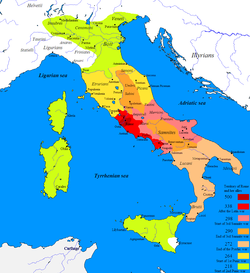| Years |
|---|
| Millennium |
| 1st millennium BC |
| Centuries |
| Decades |
| Years |
| 218 BC by topic |
| Politics |
|---|
| Categories |

Year 218 BC was a year of the pre-Julian Roman calendar. At the time it was known as the Year of the Consulship of Scipio and Longus (or, less frequently, year 536 Ab urbe condita). The denomination 218 BC for this year has been used since the early medieval period, when the Anno Domini calendar era became the prevalent method in Europe for naming years.
Events
By place
Hispania
- Fall of Saguntum to Hannibal of Carthage (or 219)[1]
- Hannibal crosses the Pyrenees and southern Gaul[1]
- Hannibal sets out with around 40,000 men and 50 elephants from New Carthage (Cartagena) to northern Spain and then into the Pyrenees where his army meets with stiff resistance from the Pyrenean tribes. This opposition and the desertion of some of his Spanish troops greatly diminishes his numbers, but he reaches the river Rhône facing little resistance from the tribes of southern Gaul.
- A Roman army under the consul Publius Cornelius Scipio is transported by sea to Massilia (modern Marseille) to prevent Hannibal from advancing on Italy, Scipio himself returns to Italy to take command of the defences in northern Italy on learning Hannibal has already crossed the river.
- Gnaeus Cornelius Scipio Calvus, Publius' brother, takes over the command of the army at Massilia and invades Spain.
Roman Republic
- Second Punic War
- In response to the threat of Hannibal the Romans assemble three armies:
- The consul prior, Publius Cornelius Scipio, raises two Roman legions and two Latin alae for a total of 22,000 infantry and 2,200 cavalry. He is also assigned 60 warships and hundreds of transports. Scipio receives the Iberian Peninsula as his area of operations (his imperium).[2]
- The consul posterior, Tiberius Sempronius Longus, also raises two Roman legions and two Latin alae for a total of 24,000 infantry and 2,400 cavalry. He gathers a fleet of 180 warships and hundreds of transports. Longus receives Sicily and Africa as his area of operation (his imperium) and was to invade Africa and attack Carthage directly.[2]
- Praetor Lucius Manlius Vulso also receives two legions and raises 10,000 allied infantry and 1,000 allied cavalry (for a total of 18,000 infantry and 1,600 cavalry) and is sent into Cisalpine Gaul to keep an eye on the Celtic tribes.[2]
- The Roman army, under consul, Tiberius Sempronius Longus, assembles in Sicily to embark for Northern Africa. Longus managed to capture Malta from the Carthaginians.[3]
- Hannibal's crossing of the Alps: Hannibal took 38 North African war elephants across the Alps from Gaul into Cisalpine Gaul to invade Rome. Almost none of the elephants survived the harsh conditions of the Alps. This led to the Romans cancelling their invasion of Africa.
- Battle of Ticinus: Hannibal defeats Scipio.
- The Roman Senate orders Sempronius Longus to travel from Sicily to reinforce Scipio's troops.
- December 18: Battle of the Trebia: Hannibal defeats the combined Roman armies under Sempronius and Scipio.
Seleucid Empire
- Negotiations between the new Egyptian King Ptolemy IV and the Seleucid King Antiochus III collapse, and Antiochus III renews his advance, overrunning Ptolemy's forward defences, and gaining territory in Lebanon, Palestine and Phoenicia.
Births
Deaths
References
- ^ a b LeGlay, Marcel; Voisin, Jean-Louis; Le Bohec, Yann (2001). A History of Rome (Second ed.). Malden, Massachusetts: Blackwell. p. 77. ISBN 0-631-21858-0.
- ^ a b c Goldsworthy, Adrian (2006). The Fall of Carthage. London: Orion Books Ltd. p. 151. ISBN 978-0-3043-6642-2.
- ^ Castillo, Dennis Angelo (2006). The Maltese Cross: A Strategic History of Malta. Greenwood Publishing Group. pp. 20–26. ISBN 9780313323294.









You must be logged in to post a comment.